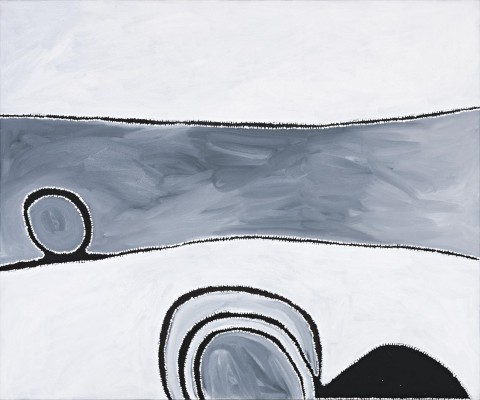THOOWOONGGOONARRIN, 2006
PADDY NYUNKUNY BEDFORD
ochres and pigment with acrylic binder on Belgian linen
150.0 x 180.0 cm
signed with initials verso: PB
bears inscription verso: title, William Mora Art Fair, and Jirrawun Arts cat. PB 6-2006-258
Jirrawun Arts, Kununurra, Western Australia
William Mora Galleries, Melbourne (stamped verso)
Private collection, Melbourne, acquired from the above in 2006
William Mora Galleries at Melbourne Art Fair, Melbourne, 2 – 6 August 2006
Paddy Bedford, Museum of Contemporary Art, Sydney, 6 December 2006 – 15 April 2007, then touring to: Art Gallery of Western Australia, Perth, 12 May – 22 July 2007; Bendigo Art Gallery, Victoria, 11 August – 16 September 2007; University Art Museum, University of Queensland, Brisbane, 16 November 2007 – 1 March 2008
Storer, R., Paddy Bedford, Museum of Contemporary Art, Sydney, 2006, pp. 116 (illus.), 159 (illus.)
Painting for Paddy Bedford was multi-layered; an expression of country and cultural memory, as well as a declaration of identity and statement of claim to the land itself. As Michael Dolk argues, painting suggests a physical and tactile relation to land, ‘To behold painting is to hold country and to remain beholden to its ancestral tradition’.1
Painting his first works in 1997, aged 75, Paddy Bedford soon became recognised as an innovator and important artist through his unique depictions of East Kimberley history and he is credited with evolving the artistic tradition forged earlier by Rover Thomas and Paddy Jaminji. Crafting his own representations of country, Bedford’s formal language is characterised by a symbiotic relationship between bold forms and an elegant, balanced composition. His painting evokes rocky escarpments, rivers and other amorphous features of the Kimberley landscape, whilst at the same time containing a learned and poetical knowledge of the land and its creation stories. As curator Russell Storer observes, ‘his paintings articulate a complex dialectic between modern materials and traditional pictorial conventions, contemporary experience and ancient belief systems’.2
Executed in 2006 and catalogued as painting PB 6-2006-258 in the chronological index of Bedford’s works, this painting represents the country of Thoowoonggoonarrin, also known as Tunganary, located to the south of Bedford Downs in his mother’s country. Tunganary Gorge is home to a permanent waterhole and is the dreaming place for Thoowoonggoonarrin, a large tree with dark leaves that is related to the fig tree (Celtis philippinensis). The artist's maternal aunt died and is buried at this place. Thoowoonggoonarrin, 2006 was one of the last paintings executed by Bedford and can be seen as a culmination of the innovative changes in style and technique he developed to create his own representations of country. Here, large dominant forms along with the interplay between positive and negative space create a strikingly beautiful rendering of country. A sublime encrusted surface with washes of white and grey create a unique translucent quality, a consequence of the artist’s wet on wet painting technique. It is important to note that multiple narratives intertwine in Bedford’s paintings. Family stories, historical events and a deep connection to his country are often masked by the simple, bold starkness of his imagery and technique.
1. Dolk, M., ‘Are we Strangers in this Place’ in Storer, R., Paddy Bedford, Museum of Contemporary Art, Sydney, 2006, p. 20
2. Storer, R., Paddy Bedford, Museum of Contemporary Art, Sydney, 2006, p. 11
CRISPIN GUTTERIDGE
